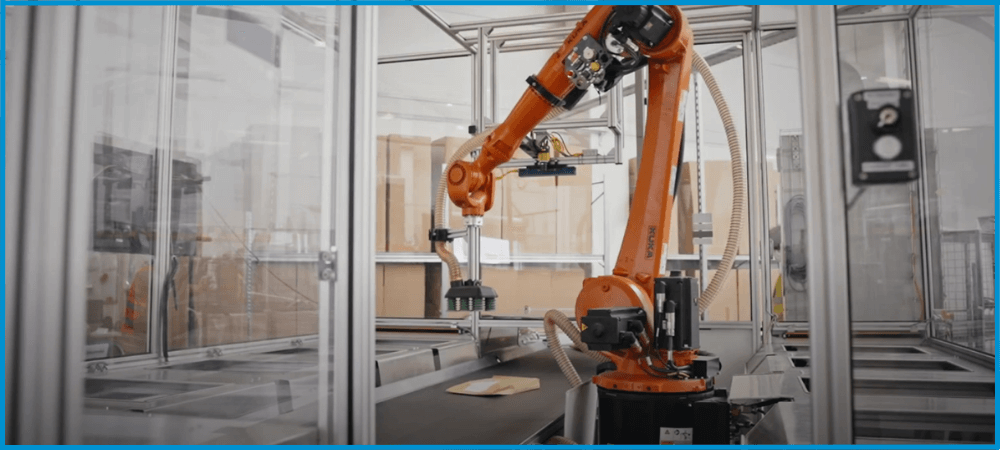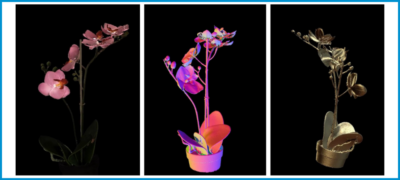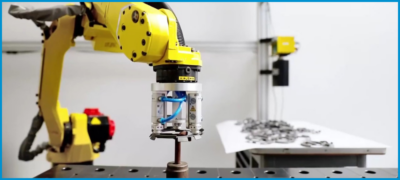
Picking in motion in the IIoT world
According to the Market Research Engine, the Industrial Internet of Things (IIoT) market will grow at a compound annual growth rate of more than 8% over the next five years.
As such, the IIoT can be seen as the next frontier that brings a new level of productivity and efficiency to factories across the whole globe. It is a key element of smart manufacturing and a necessity for all companies that look for a competitive advantage.
Of course, the IIoT does not exist on its own – it is dependent on an interplay of the most advanced technologies, including robotics, artificial intelligence (AI), machine vision, cloud computing systems, data analytics systems, and others. This article will focus on the importance of machine vision and the latest advancements in the field that shape the IIoT and define applications that can be automated within its context.
Let’s unpack this step by step by explaining first what the Industrial Internet of Things actually is.
What is the Industrial Internet of Things, or IIoT?
The Industrial Internet of Things is a network of connected smart devices and real-time data analytics – and the use of these technologies – in industrial applications of manufacturing industries. It represents the most advanced form of automation to allow seamless production and non-stop optimization through predictive maintenance and remote monitoring. IIoT technologies drive fast and accurate business decisions, increase productivity and efficiency, maximize product quality, enhance worker safety, save time, and reduce costs by minimizing the wastage of resources.
The IIoT is a key element of a Smart Factory and as such, it is tightly coupled with the 4th Industrial Revolution, or Industry 4.0.
Now, what is the role of machine vision in the IIoT?
Machine vision in the IIoT
The industrial machine vision market is growing at a record pace. Advancements in machine vision are among the main drivers of advanced industrial applications and factory automation; especially 3D imaging is given paramount importance within this niche.
The growing adoption of 3D machine vision technologies in IIoT applications is driven by its increasing affordability, improving capabilities from both the software and hardware side, and an expanding array of applications. These include robot guidance, object handling and sorting, product inspection and quality control, real-time process control, and many other applications.
Until recently, 3D machine vision limited the above application areas to static scenes. This meant the following:
Objects moving on a carrier needed to be halted to be scanned and handled by a robot. Similarly, a robot guided by 3D vision attached to its arm needed to stop moving for each scan acquisition. This has a simple reason.
Conventional 3D sensing technologies for scanning large work areas are not able to scan moving objects in high quality.
Until recently, the most popular technologies the market offered for scanning objects in motion have been Time of Flight or active stereo systems. Their main advantage is speed and long scanning range. But they have a major limitation – their resolution is often VGA (Video Graphics Array = a resolution standard for displaying graphics on monitors) and their accuracy can only achieve several millimeters. In addition, they cannot provide nice details on edges and the whole 3D image has rather high noise.
Therefore, if you need high quality, structured light sensors may be the right choice. They can scan all kinds of materials and surfaces in various working conditions, providing robust data and high accuracy. However, they also have a fundamental limitation – they can only be used if the scene is perfectly static as they are not able to scan moving or vibrating objects. This is because a structured light system projects a sequence of light patterns onto a scene and if the scanned object moves, the projected pattern gets broken. The result is high noise, flying artifacts, or even an incomplete point cloud.
So, how to get both high quality and fast speed of 3D scanning?
Photoneo’s novel, game-changing technology combines the speed of ToF/active stereo systems and the quality of structured light systems – as the only one on the market. It is called the Parallel Structured Light and provides a high-resolution point cloud with 900 000 3D points, submillimeter accuracy, low noise, detailed contours, high robustness, completeness of the scan on various materials, and high quality on edges. And the most important thing is – all this can happen in motion.
This transforms IIoT applications from the ground up.
Extending the array of IIoT applications with motion
The Parallel Structured Light, which is implemented in the Photoneo 3D camera MotionCam-3D, transforms automation by enabling completely new applications and by shortening cycle times and latency in the existing ones.
In hand-eye robotics, the robot does not need to stop anymore to make a scan and then perform the required action as the technology provides a continuous stream of high-quality 3D data even during random movements or vibrations.
The Parallel Structured Light can also speed up conventional 3D applications such as the manipulation of objects in 3D space or the evaluation of their quality during the manufacturing process. An example of such an application is the recognition and picking of objects placed on a moving carrier and their subsequent sorting according to certain criteria – such as OK or NOT OK.
Besides manufacturing processes, the technology also extends the IIoT’s potential to sectors such as logistics, e-commerce, and others. It can be used for the identification of parcels passing on a conveyor belt or an overhead conveyor and navigating a robot to pick them, sort, and drop them into the right container or other location. By combining the Parallel Structured Light with artificial intelligence (AI), its potential and application range extend even further.
3D machine vision is a key element of the Industrial IoT and while its advancements shape the whole IIoT world, the IIoT, in turn, shapes 3D machine vision trends. As the IIoT becomes a standard in modern factories, we can expect rapid growth in connected machine vision systems, AI, and other core elements. This connected network will make it possible to analyze, understand, and optimize the manufacturing and logistical processes in any industrial setting.



